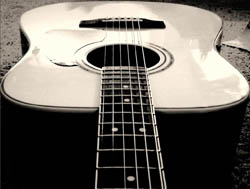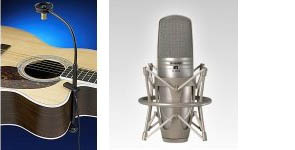
Combo Systems
Pros: Blending the best of both worlds – the articulation and feedback rejection of a piezo system combined with the natural warmth and tone of an internal microphone. These systems usually include the ability to blend the two sources any way you want – giving you the best of both options.
Cons: Can be pretty pricey and can require extensive modification to the guitar (not for vintage instruments!).
Connection to PA: Sometimes requires two connections – a direct box for the pickup and an XLR for the mic.
External Microphones
Pros: Very high sound quality, reproducing the beauty of the instrument.
Cons: Very susceptible to feedback if put in the monitors at a high level. Not enough separation from other instruments (the mic will also pickup drums, bass, brass, monitors, stage noise, etc.).
Connection to PA: Standard microphone cables.
TYPES OF PREAMPS
After we have our pickup system, the next thing to review is the external preamp options (if needed). There are basically three grades of these:
—Music store preamp boxes. These are the most common and can give very good results right out of the box for around $150. Two popular units are the L.R. Baggs Para DI and the Fishman Pro EQ.
—Boutique boxes. These are targeted more at the discerning professional, and can range from $500 and up. A popular choice (among many) is the Avalon U5.
—Special purpose boxes. There are a myriad of other options out there. One pretty common device in the Taylor community is the Taylor K4.
TYPES OF MONITORING
Along with the on-board and external electronics, the next thing to consider is how the guitarist will hear his amplified sound. In a loud stage environment with drums and electric guitar amps, there are three primary options:
Acoustic Guitar Amplifier. There are many good makes and models of acoustic guitar amps now. In a shared-mix environment where the guitarist is sharing a monitor mix with others, this is probably the easiest solution.
The signal chain goes like this – from the guitar’s internal or external preamp into a high-quality direct box, which in turn provides an XLR connection to the mixing console.
But it also has a parallel input or pass-through that you can use to connect to the amplifier. Doing it this way means the guitarist can adjust the volume and EQ setting on his amp without affecting the signal that goes to the board.
NOTE: There is a big difference between a typical electric guitar amp and a nice acoustic amp. The acoustic version is made for full frequency response and often includes a high frequency horn, whereas the electric guitar will roll of high frequencies dramatically.
Floor Monitor Wedge With A Dedicated Mix. The dedicated mix would most likely be an unused aux send from the mixing console. This allows the guitarist to have his own blend of instrument and mic he wishes to hear, along with a healthy dose of himself.
In-Ear Monitors With A Dedicated Mix. This solution ensures that the guitarist can hear as much of himself as he wants, and will be isolated from other loud sounds on stage. It is an elegant approach, but comes with a significant upfront investment.
Jeremy Carter is a veteran of the pro audio industry with extensive experience designing and operating church audio, video, and lighting systems. Learn more at Sound Sessions.




